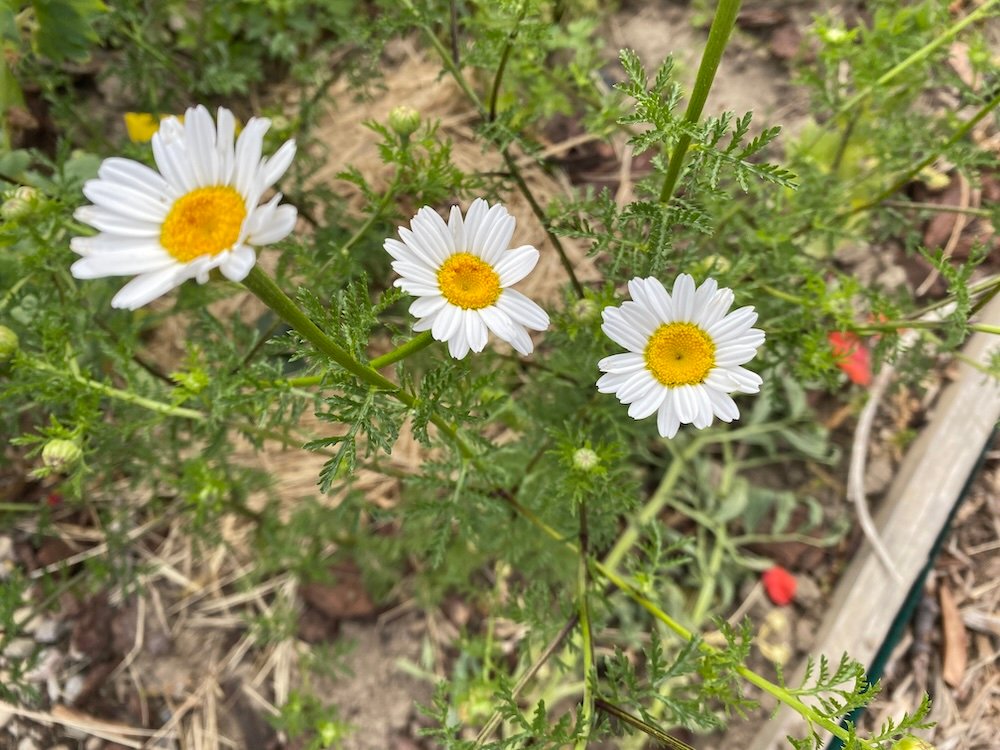I have never seen as many different flowering weeds as I have here in the South of France – within my garden and also on my walks around the villages or in the garrigue. They provide great inspiration and ideas for what kinds of plants will “work” in the garden and/or they can be used in the garden, permanently or as temporary groundcover.
Anthemis / Anacyclus?

I’m not sure what it is – a sort of Anthemis or Anacyclus clavatus. In any case they would be close relatives within the Asteracea family. It is definitely a native wildflower and blooms in May. Because it’s inoffensive, non-invasive and looks pretty with its daisy-like flowers I’m letting it stay.
Borago officinalis

Native to the mediterranean, grows wild in many places. I actually don’t really like this plant because of its prickly leaves, but I love to put the little blue flowers in salads. And the bees are just crazy about it when it appears in spring.
Easy to control in the garden.
Calendula arvensis

A Mediterranean native (although it is now found in many regions of the world) and probably the origin of calendula officinalis. Grows all over the countryside in vineyards, fields, and meadows and blooms in spring
Cerinthe major

Also native to the mediterranean. I have not seen it in the wild but it grows profusively in my garden from December through April. The speckled blue-green leaves are pretty, the little yellow-brown flowers not showy but incredibly popular with bees in the late winter and early spring. From April on it starts to look less pretty and as other things come into season I pull out the waxflowers.
Easy to control in the garden.
Chenopodium album

My first sighting of chenopodum album in the garden was a happy one. After all this ancient wild plant is quite edible, full of nutrients, and even decorative looking. But since I’ve seen how gigantic it can grow if left to its own devices, how prolifically it reseeds (even if you think you’ve cut it in time) and how hard it is to get rid of, I’ve started to meticulously pull it out wherever I see it crop up in early summer.
Fumaria officinalis / capreolata

A native to Europe that I had never seen before. Here in my garden it grows profusely and I like it for its delicate appearance. I leave it as ground cover in spring and then pull it up as other plants need the space. It is somewhat poisonous and used as an herbal remedy in some countries.
Easy to control in the garden.
Geranium / Erodium

I am not quite sure what type of geranium this is. Along with its brethren Erodium malacoides etc. it sprawles all over the garden and covers empty areas very quickly in early spring. It has a deep root but tends not to come back during the summer, when I pull it out in later spring as other plants need the space. Easy to control in the garden.
Iris

Iris are some of the most hardy, robust, drought and heat resistant flowers there are. On the floor of the small woods of the Garrigue Iris lutescens are flowering in February and in the countryside one finds naturalized Iris barbata.
Plantago lanceolata

I’ve never before seen plantago plants this big – it must really like this climate and this poor soil. Because it is a healing plant and because it looks quite beautiful in its own way I let it grow and just try to keep it from reseeding. It dies off in the summer heat anyway and can be easily dug up and discarded in the fall.
Silene latifolia

A native of Europa and North Africa, it spraws all over my fruit garden. In the North of Europe the flowers open in the late afternoon to attract insects. Here in the Mediterranean they open in the morning and close in the late afternoon.
It begins innocuous but develops into unwieldy low bushes with deep roots and needs to be kept in check.
Malva sylvestris

Do not be tempted by these lovely little flowers seen all over the countryside in summer.
In the wild they grow into to middling sized, slim and straight perennials or pretty groundcovers that survive the worst heat and drought.
But in the somewhat richer soil of my garden they develop at record speed into awkward monsters, pushing out long side branches and growing over everything else. And pushing a taproot from hell deep into the ground – needing a pickaxe and a spade to remove…
Leave a Reply